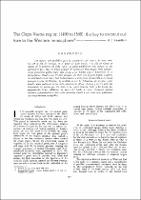The Cape Verde region (1499 to 1549); the key to coconut culture in the Western hemisphere
Fecha de publicación
07-1977Autor
Harries, H.C.
Tipo
Artículo
Metadatos
Mostrar el registro completo del ítemTítulo alternativo
La región del Cabo Verde (1499 to 1549); la clave del cultivo del cocotero en el hemisferio Occidental
Resumen
The most likely sites for the introduction of the coconut to the Atlantic seaboard are the island of Saniago, in the Cape Verde group, or the island of Gorée, to the southeast of the Cape Verde peninsula. The earliest possible date for an introduction was 1499 and the probable source of seed was Mozambique. Later introductions could have been made to the same sites from the same source. Within 50 years, by 1549, one or both of these locations became a centre for dissemination to other parts of the Western Hemisphere (except the Pacific coast). The result is that coconut populations now considered endemic to the Atlantic coasts of Africa, America and around the Caribbean are basically the same as coconuts in East Africa, India and Sri Lanka. Epidemic lethal diseases in parts of the Caribbean and West Africa could continue to spread to all of these territories because these coconut populations are completely susceptible.
Palabras clave
Cocos nucifera||Cocos nucifera||Cocos nucifera||Cocos nucifera, Coco||coconuts||coco||noix de coco, Caribe||Caribbean||Caraíbas||Caraïbes, Cabo Verde||Cabo Verde||Cabo Verde||Cabo Verde, América del Sur||South America||América do Sul||Amérique du Sud, Africa Central||Central Africa||África Central||Afrique centrale,
Representación
Sede Central
Editor
Instituto Interamericano de Cooperación para la Agricultura (IICA)
Es parte de
Turrialba; Vol. 27, no. 3
Status
openAccess
URI (Enlace permanente para citar o compartir este ítem)
https://repositorio.catie.ac.cr/handle/11554/12531Colecciones
- Turrialba [2688]


